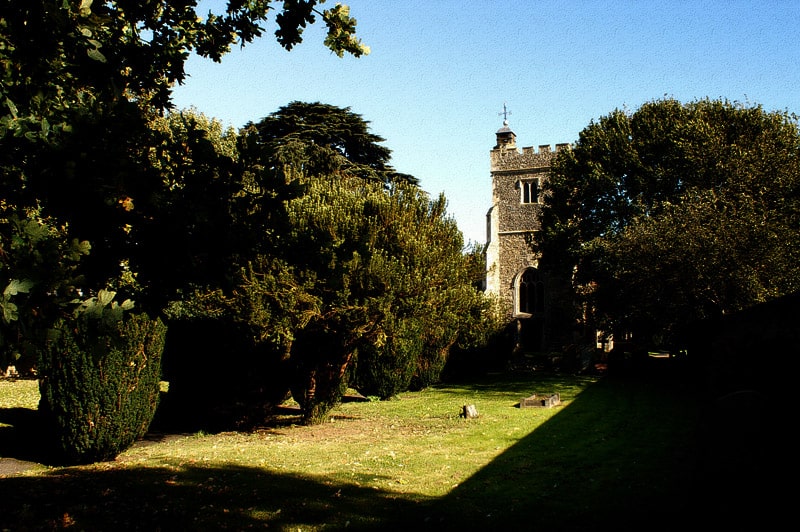Brian Cuthbertson, Head of Environment and Sustainability at the Diocese of London

The Churchyards Ecology Survey is the first phase in a multi-year project called ‘Churchyards for London’.
Depending on how you count them, there are about 600 churchyards in Greater London, yet we know surprisingly little about them, especially about the wildlife and ecosystems they support, or the contribution they make to London’s biodiversity. In spite of surveys conducted by the London Wildlife Trust and others over the last few decades we lack a systematic habitat survey across the whole stock.
This information will not only add to our knowledge, but also inspire church congregations, visitors and the wider public to appreciate the living world on the doorsteps of their churchyards, to cherish them and improve their maintenance.
This study is a joint project between the Church of England Dioceses of London, Southwark and Chelmsford, funded from diocesan funds and supported by Natural England and several trusts.
Church of England dioceses have been established for centuries – the administrative area of Greater London only since the 1960s. Most of the London Diocese is in the City and 151/2 other London boroughs. The Diocese of Southwark is all south of the Thames, with about half of it in nine and a half London boroughs. A smaller part of Chelmsford Diocese occupies five London boroughs. This constitutes our study area. The areas of Greater London not covered (parts of Barnet, Merton, Bromley and Kingston) are in St Albans, Rochester and Guildford Dioceses. These are out of our scope, at least for the time being, but the 85% of Greater London covered by this study gives us sufficient overview and spread.
Tenders for the work were obtained from five nature conservation ecology units and URS Infrastructure & Environment Ltd were appointed as our ecologists in January 2013.
At this stage we did not know which of the over one thousand church and associated sites within the study area included churchyards. Using satellite photography, plus information from sources including Pevsner’s ‘Buildings of England’, London Gardens Online, local authority parks and gardens departments, and data held by the three dioceses, we were able to identify those with significant open space and wildlife potential.
We defined churchyards as not just graveyards, but any church curtilage or significant open spaces associated with churches. Municipal cemeteries aren’t included. From the 1,119 sites in the study area, 892 sites qualified as relevant sites, of which 547 exceed c 0.1 acres, and of these, 479 showed sufficient indications of the presence of wildlife – chiefly some grass or trees.
A group of 50 was then selected using statistical means to represent:
- Five inner and five outer London boroughs, evenly distributed and proportional to the land areas of the three dioceses
- A range of urban, suburban, peri-urban and rural characteristics
- Varying sizes (approx. > 1.5 acres, 0.5-1.5 acres, 0.1-0.5 acres)
- Geological landscape types, and water and wetland bodies
- Habitats suitable for trees and flowers, birds and mammals, amphibians and reptiles, invertebrates, lichens and bryophytes.
URS carried out a desk study of the environs of these 50 sites and ranked them according to their biodiversity potential using species records from within a 500m radius of the centre of each site. We want to pay particular tribute to GiGL, particularly Matt Davies and Mandy Rudd, for supporting the study so generously by providing these species records (including protected and invasive species records), as well as habitat information and information on protected sites.
Extrapolating from the areas in scope we’ve been able to reach some very broad conclusions. Churchyards may occupy a total of about 270ha, or one sixth of one percent of the land area in Greater London.
Considering their distributed locations and contribution to green space connectivity, the ecological potential of these sites appears disproportionate to their size. GiGL data show that more than 200 significant species have been observed and no fewer than 114 designated sites are within 500m of the 50 sites. That’s before site surveys have had a chance to discover what species or habitats may exist within the churchyards, and may or may not also be present in nearby designated sites or other green spaces.
To the non-specialist eye, the most obvious feature of churchyards visible from aerial photographs is the number and density of trees they support. In many cases, especially in Richmond and in parts of Croydon, this density and tree species richness is similar to surrounding properties. In other areas, churchyards are densely wooded while their surroundings seem barren. This bodes well for the capacity of churchyards to act as refugia for certain species.
A short list of 30 sites of greatest potential has now been selected for site visits. Second stage studies will now research these in greater detail. We’ll be using GiGL’s standard spreadsheet to return data for inputting to the GiGL partnership database. Visits are to be undertaken from summer to autumn 2013 and from spring and autumn 2014.
To be continued …
